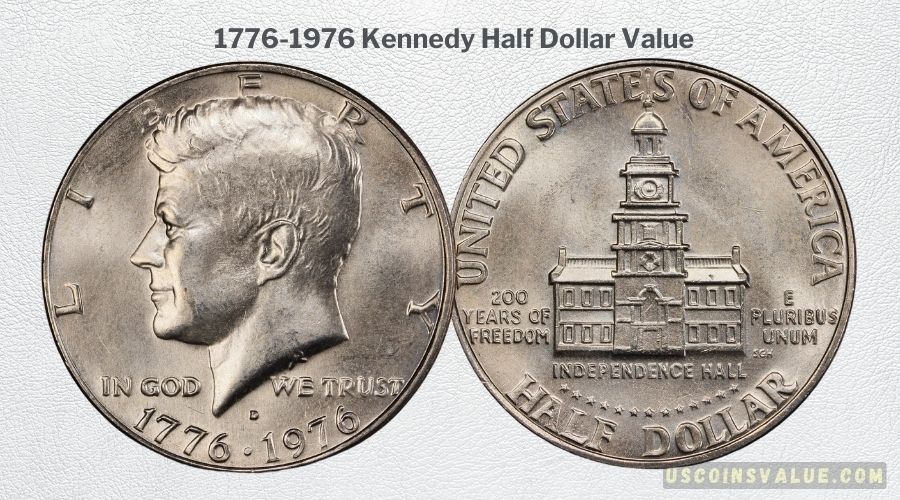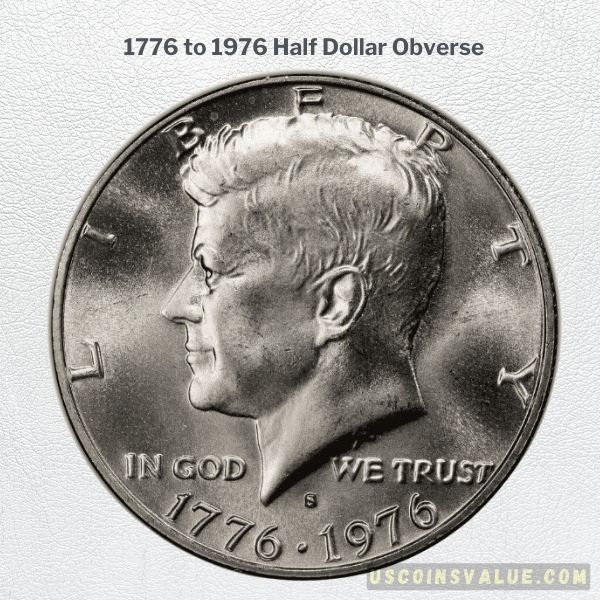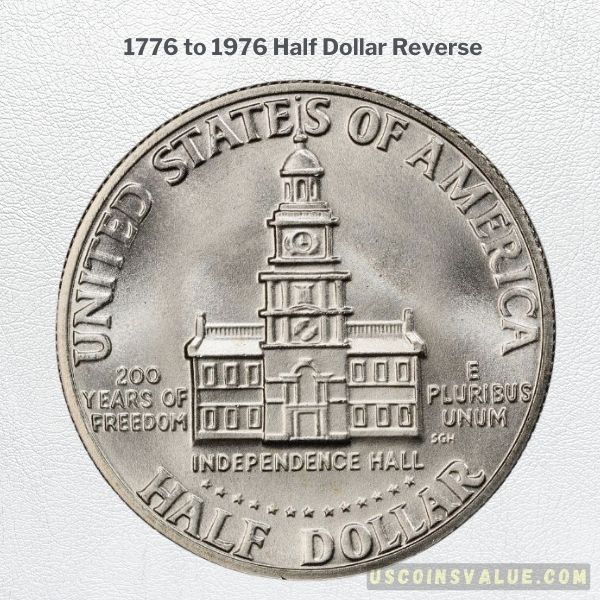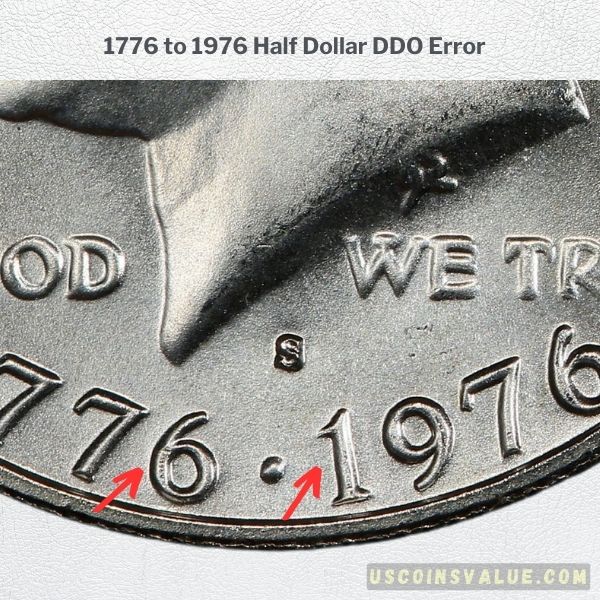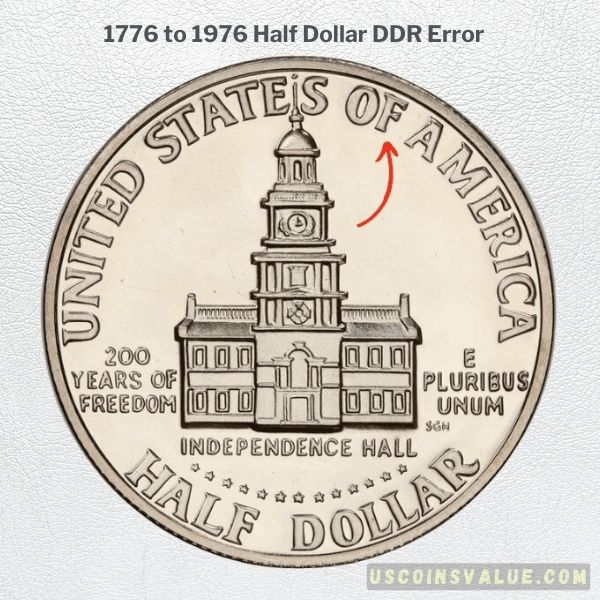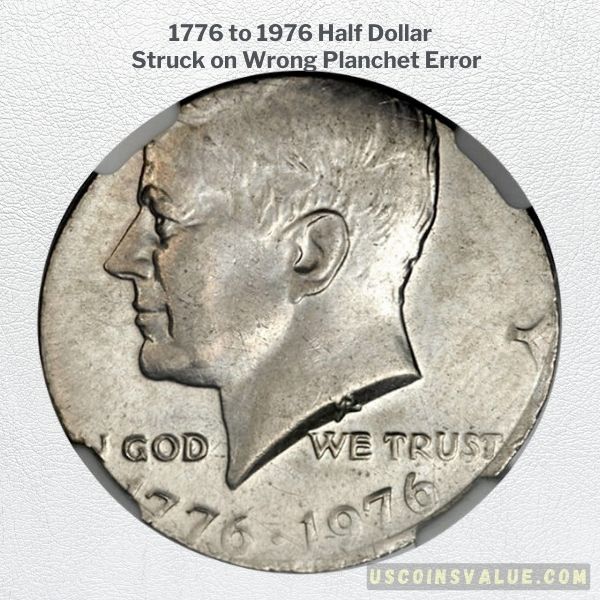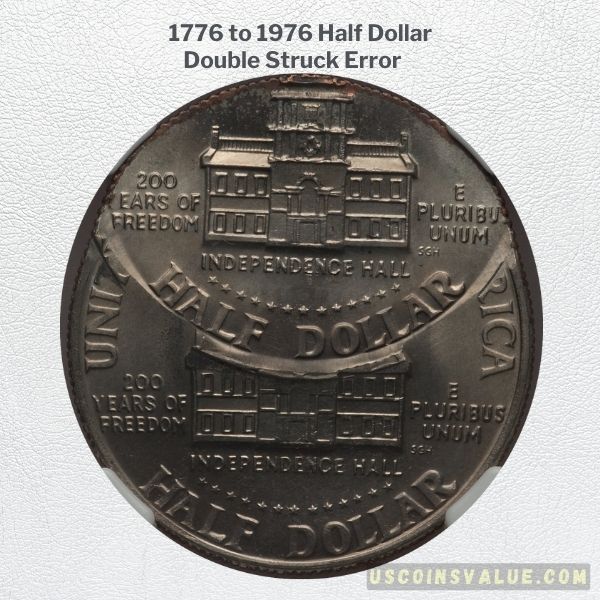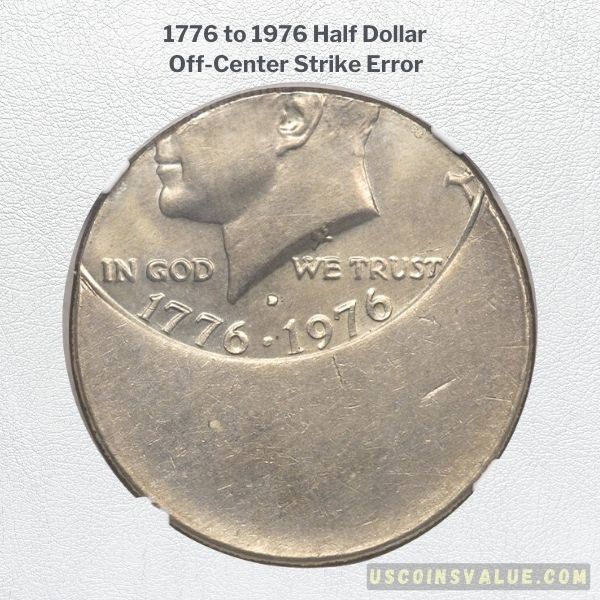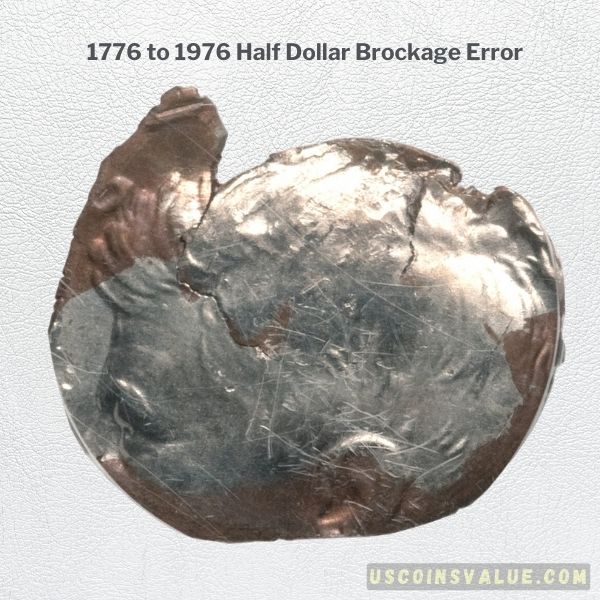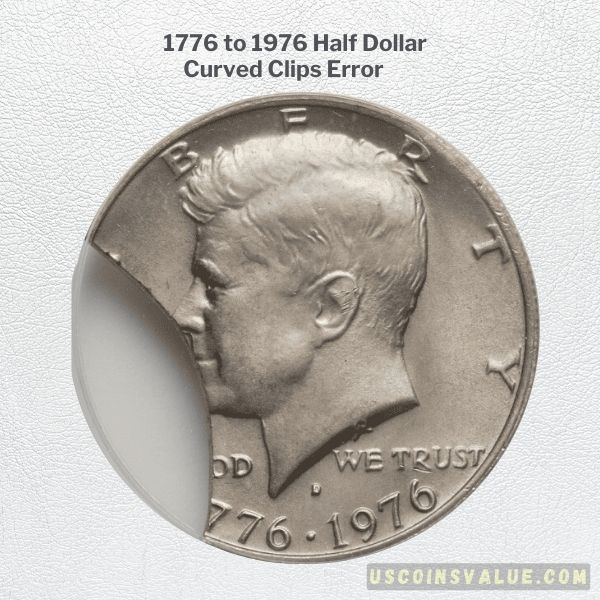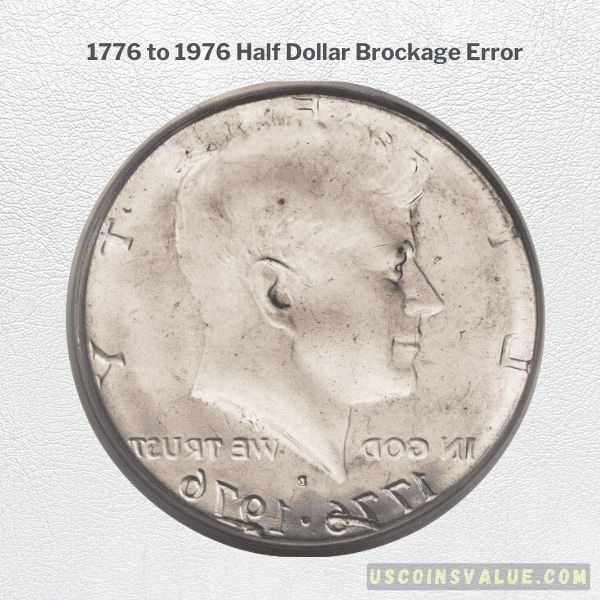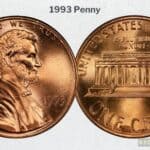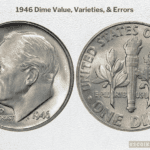The most valuable Bicentennial Half Dollar is the MS69 grade 1776-1976-S Kennedy Half Dollar that sold for $9,600 in 2022.
Also known as the Bicentennial Kennedy half dollars, these are among the most valuable commemorative coins, selling for more than $2,000 in their best conditions.
On average, the Bicentennial half-dollar is valued at about $3-$5 in uncirculated Mint set condition. However, the value goes higher when the coin features interesting mint errors, has a higher grade than MS67, and has a silver composition.
In this article, we’ll explore the historical significance of the Bicentennial Half Dollar, its features, mint varieties, and what makes these coins valuable.
We’ll also dive into the various mint errors and discuss whether Bicentennial Half Dollars are worth anything in today’s market.
What Is A Bicentennial Half Dollar? History and Background
Bicentennial is a word used to describe the 200th anniversary of a specific event. Over the years, the U.S. Congress has commissioned the development of commemorative coins, some of which were authorized to commemorate the 200th anniversary (bicentennial) of special American events and places.
Bicentennial Commemorative Coins
An example of these bicentennial coins includes the 1994 issued ‘U.S. Capitol Bicentennial Silver Dollar’ made to commemorate the 200th anniversary of the U.S. Capitol building. Another one is the ‘Congress Bicentennial Dollar’ made to commemorate the 200th anniversary of the U.S. Congress.
In our case, we will be looking at the ‘1776-1976 United States Bicentennial 3-Coin set’ produced to commemorate the 200th anniversary of the signing of the Declaration of Independence.
The Declaration of Independence was signed in 1776, and the mintage of these coins began between 1975 and 1976, marking the 200th anniversary of Independence in the United States.
This commemorative set of three coins was made up of the Eisenhower Dollar, the George Washington Quarter, and the Kennedy Half Dollar – all with the double date ‘1776-1976’ stamped on the obverse side.
These coins came about due to the introduction of bills by the U.S. Congress in the mid-1970s—the bills aimed to promote the celebration and honor of America as an independent republic.
Dubbed the ‘United States Bicentennial, ‘ this series of celebrations in the mid-1970s ensured Americans paid tribute to historical events that led up to the signage of the Declaration of Independence by the Founding Fathers in 1976.
As part of the ‘1776-1976 United States Bicentennial 3-Coin set,’ the Kennedy Half Dollar was redesigned to pay tribute to these celebrations.
Kennedy Half Dollar Redesign for Bicentennial
The half-dollar dates back to 1794:
However, the Kennedy Half dollar itself came much later in 1964, when it was first introduced to honor the memory of President John F. Kennedy following his tragic assassination on November 22, 1963. Since its inception, these coins have remained collectible mementos of the 35th president’s life and legacy.
Before the bicentennial years of 1975 and 1976, the Kennedy Half Dollar featured the Presidential Seal on the reverse while the obverse featured President John F. Kennedy’s Profile.
The reverse design was later altered during the bicentennial years to create the 1776-1976 Bicentennial Kennedy Half Dollar (also known as the Bicentennial Half Dollar).
The new design featured a revamped reverse side with a centered image of the Independence Hall located in Philadelphia – this is where the Declaration of Independence was debated and adopted.
Fun Fact: Did you know U.S. citizens designed the 1776-1976 United States Bicentennial coins’ reverse side through a competition? The U.S. Treasury announced the competition in October 1973, allowing any U.S. citizen to submit drawings/photographs of their models.
In March 1974, the winners were announced, and the winning design for the Bicentennial Kennedy Half Dollar came from Seth G. Huntington, a talented coin sculptor, designer, and engraver from Minneapolis.
He won $5,000 from the competition, and as the winner, his initials ‘S.G.H.’ were engraved onto the reverse side of the coin.
The other two winners were Jack L. Ahr, who designed the reverse of the Bicentennial George Washington Quarter, and Dennis R. Williams, who designed the reverse of the Bicentennial Eisenhower Dollar. Both their initials were also added to their respective coins.
The Legacy of the Bicentennial Kennedy Half Dollar
The Bicentennial Kennedy Half Dollar was the first of the three coins to be issued on July 7, 1975, in a ceremony held at Seth G. Huntington’s hometown, Minneapolis, Minnesota.
These coins were minted in high volumes (over 550 million mintage) in all three mints: Denver, Philadelphia, and San Francisco.
Despite their high mintage, the Bicentennial Half Dollars are still considered collectibles because they were only minted in a short one-year period. Today, finding them in pocket change is hard, but you can easily buy them from your bank or the secondary market.
Two versions of the bicentennial half dollars were made: copper-nickel-clad and silver-clad. That is the other reason why this short series is in high demand.
The copper-nickel-clad coins were regular finish coins made in all three mints for circulation/business use. On the other hand, silver-clad coins were only made in the San Francisco mint and were not included in the circulation coins – sold to collectors and kept for numismatic purposes.
These San Francisco silver-clad coins came from silver planchets and were minted in low numbers (less than 15 million) compared to the copper-nickel coins.
They consist of Proof Silver Coins and Uncirculated Silver Coins; both valued higher than the copper-nickel clad Bicentennial half dollars.
Features of the Kennedy Half Dollar 1776 to 1976
Kennedy Half Dollar specifications:
- Series: Kennedy Half Dollars 1964 to Date
- Year of Make: 1975-1976
- Mint Branch: Denver, Philadelphia, and San Francisco
- Composition: Copper-Nickel Clad and Silver Clad Versions
- Mass/Weight: 34 grams for copper-clad and 11.50 grams for silver-clad versions
- Diameter: 6 millimeters
- Edge: Reeded
1776 To 1976 Half Dollar Mint Varieties
The 1776 to 1976 half dollar was produced in the three mints: Philadelphia (P), Denver (D), and San Francisco (S). On the coin’s obverse side, Denver and San Francisco mints are represented by mintmarks ‘D’ and ‘S’, respectively. Philadelphia coins did not feature any mint marks.
Since there are two types of Bicentennial Half Dollars: the copper-nickel clad version and the silver-clad version, you may be wondering, how much silver is in a 1976 Bicentennial Kennedy half dollar?
The short answer is 40% silver, but the silver-clad coin is technically made up of two layers: The Outer Layer with 80% silver and 20% copper, and the Center Layer with 79% copper and 21% silver – totaling 40% silver and 60% copper.
On the other hand, the Copper-Nickel Clad version is made up of 91.67% copper and 8.33% nickel. The key difference between the two is the weight and color.
Copper-nickel-clad coins weigh 11.30 grams, while silver-clad coins weigh 11.50 grams. Also, copper-clad coins turn more of a copper color as they age, whereas silver coins will become tarnished with age.
The three mints produced five different varieties of the 1776-1976 Kennedy half dollar. Below is a summary table showcasing the five coins and their mintage:
| Bicentennial (Kennedy) Half Dollar Variety | Composition | Mint Location | Mintage |
| 1. 1776-1976-D (Regular Strike) | 91.67% copper and 8.33% nickel | Denver | 287, 565,248 |
| 2. 1776-1976-P (Regular Strike) | 91.67% copper and 8.33% nickel | Philadelphia | 234,308,000 |
| 3. 1776-1976-S Silver (Regular Strike) | 40% silver and 60% copper | San Francisco | 11,000,000 |
| 4. 1776-1976-S (Proof Strike) | 91.67% copper and 8.33% nickel | San Francisco | 7,059,099 |
| 5. 1776-1976-S Silver (Proof Strike) | 40% silver and 60% copper | San Francisco | 4,000,000 |
Obverse and Reverse Design
The obverse (heads) features John F. Kennedy’s bust image facing the left. Inscriptions include:
- LIBERTY – covers the top half of the upper rim
- 1776 -1976 – at the bottom of J.F.K.’s image
- IN GOD WE TRUST – above ‘1776-1976’
- ‘D’ or ‘S’ Mint Mark – appears between ‘1776-1976’ and ‘IN GOD WE TRUST’
The reverse (tails) features a frontal view of Independence Hall in Philadelphia. Inscriptions include:
- UNITED STATES OF AMERICA – at the top of the image
- HALF DOLLAR – at the bottom
- 200 YEARS OF FREEDOM – on the left side of the image
- E PLURIBUS UNUM – on the right side of the image
- SGH – below ‘E PLURIBUS UNUM’
- INDEPENDENCE HALL – below image
What Makes The Bicentennial Kennedy Half-Dollar Valuable?
To answer this question, you must also ask – What makes a 1776 to 1976 half-dollar rare?
With a mintage of over 500 million, Bicentennial Kennedy half dollars are generally not considered rare. However, there are a few rare varieties in its category that make the coins more valuable, and this includes the following five types of coins:
- Circulated variety in MS67 or higher
These coins have sold for $5,000 and above at auctions. MS69 is the finest and most valuable grade ever recorded (only three are known to exist), but this is for the San Francisco silver uncirculated coins.
One sold for $9,600 at Heritage Auctions in 2022, and the valuation for MS69 across all markets is $12,500 – $25,000.
Circulations copper-clad coins have only been found in MS67 or MS68 at best, and since they are harder to find in high conditions, they tend to be more valuable.
- Mint Errors
Valuable bicentennial half-dollar errors include Double Struck, Struck Off Center, and Wrong Planchet errors. Some have sold for over $5,000, including the MS65 grade Deep Die Cap and Brockage error coin that sold for $5,170 in 2017.
- PR70 Proof Sets
Proof sets graded at PR70 (highest possible grade) are seldomly seen in Bicentennial half dollars.
These coins go for about $1,000 – $5,500; most have sold at auctions for more than $2,500. An example is this one that sold for $5,175 in 2008.
- Silver Content
The 40% silver-clad version was not intended for general circulation; thus, they have a lower mintage than regular copper-nickel-clad coins.
The silver content alone adds intrinsic value to these coins, making them highly desirable to collectors and investors. The 50C silver circulation coins in MS68 states or higher are valued at over $200.
- Artist Edition Proof Sets
These are sets of bicentennial (Proof) silver coins signed by respective designers – including Dennis R. Williams for the Bicentennial Silver Dollar Coin, Seth Huntington for the Bicentennial Silver Half Dollar, and Hack L. Ahr for the Bicentennial Silver Quarter.
You can get a set of all three for less than $200. On auctions, an individual bicentennial half-dollar ‘artist edition,’ signed by S.G.H., goes for about $80.50 in PR69 Deep Cameo grade.
1776 To 1976 Half Dollar Value
So, with all the above considerations, what is a 1776 to 1976 half-dollar worth?
The Bicentennial Half Dollar has a minimal face value of 50 cents and a melt value of $0.1076 in copper-nickel composition or $3.4711 in silver-clad composition.
According to the U.S.A. Coin Book, on average, the copper-clad variety costs above $3 in uncirculated (MS+) Mint condition and above $4 in proof P.R. condition. Silver clad variety cost about $10.61 in uncirculated (MS+) Mint condition and above $15 in proof P.R. condition.
However, the ceremonial coin sells for more than these minimal prices since it is valued higher than its intrinsic value by collectors and enthusiasts. The most valued Bicentennial half dollar is the MS69 grade 1776-1976-S Kennedy Half Dollar that sold for $9,600.
Below is a summary value chart showcasing Bicentennial Half Dollars and how much they are valued:
| 1776-1976 Kennedy Half Dollar Grades | 1776-1976 -D
Copper-Nickel (MS) |
1776-1976 -P
Copper-Nickel (MS) |
1776-1976-S
Silver (MS) |
1776-1976 -S Copper-Nickel
(Proof) (PR) |
1776-1976 -S
Silver (Proof) (PR) |
| 60 | $1.25 – $6 | $1.25 – $3 | $5 – $8 | $5 | $7 |
| 61 | $1.50 – $7 | $1.50- $4 | $5.50 – $9 | $5 | $7 |
| 62 | $2.25 – $8 | $2- $5 | $6 – $10 | $5 | $7 |
| 63 | $8 – $12 | $8- $12 | $8.50 – $11 | $5 – $6 | $8 |
| 64 | $15 – $22 | $15- $20 | $10 – $14 | $5- $9 | $11 |
| 65 | $20 – $30 | $30- $65 | $18 – $22 | $6 – $10 | $12 |
| 66 | $45 – $65 | $135- $175 | $28 – $30 | $7 – $11 | 413 |
| 67 | $975 – $1,150 | $1,850 – $1,750 | $36 – $47 | $8 – $12 | $14 |
| 68 | N/A | N/A | $140 – $220 | $9 – $13 | $14 |
| 69 | N/A | N/A | $12,500 – $25,000 | $18 – $22 | $28 |
| 70 | N/A | N/A | N/A | $375 – $450 | $275 |
Note:
- The N/A in columns without a price guide does not mean the coins are rare. Instead, it shows that there isn’t enough data or coins to publish an average price estimate.
- The grades (60 – 70) represent the particular coin’s grading prefix, i.e., MS60-MS70 for Mint State (M.S.) or PR60-PR70 (P.R.) for Proof coins.
Rarest & Most Valuable Errors of the 1776 To 1976 Half Dollar
Errors are unintended mistakes that occur during the coin production process. Collectors find these errors interesting and more valuable. The rarer the error, the more valuable the coin.
The coin’s value increases even further when more than one error is recorded on a single coin. An example is the PR65 Proof Coin that sold for $5,280 in 2023, containing two errors – Double Strike Error and Wrong Planchet (Struck on a Cent Planchet Error).
The list below contains familiar and highly valued rare errors bound to fetch you a good payday in the open market.
1. Double Die Obverse
Also known as the 1976-S 50C silver D.D.O. Fs-101, this variety contains a Double Die Obverse error found in coins made in the San Francisco mint.
The Double Die Obverse (D.D.O.) error occurs when the obverse (front) die used in production is engraved with the design elements twice, slightly misaligned.
This results in a doubled appearance of certain details on the coin’s obverse. The doubling effect is most noticeable on the inscriptions, date, and sometimes on the portrait or other prominent design elements.
In this case, there is a strong doubling on the ‘WE TRUST’ lettering. You will need a magnifying tool to spot this variety.
An example sold for $780 at Heritage Auctions in 2018 and another for $204 in 2017.
2. Double Die Reverse
Officially known as the 1776-1976-S 50C Clad DDR FS-801 (Proof) coin, this coin variety features a Double Die Reverse error where a doubling effect can be seen on the reverse side, caused by a reverse die with doubly engraved elements.
Use a magnifying glass to look at the Doubling on the letters; strong doubling is on the letters ‘E PLURIBUS UNUM’.
The highest auction record for the regular proof coin is the PR66, which sold for $881 at Heritage Auctions in 2016, and the PR67, which sold for $1,100 at Great Collections in 2013. The highest record for Cameo is $1,000 for PR67CAM.
PCGS values DCAM varieties above PR68DCAM at $1,600 or more. C.A.M. varieties are valued at $500 for PR65CAM up to $1,400 for PR68CAM. Regular proof varieties, on the other hand, are valued at $400 in PR65 and $700 at PR67.
3. Struck on Wrong Planchet/Blank Error
A wrong planchet error occurs when a coin is struck on a blank or planchet (the metal disc from which a coin is struck) intended for a different denomination or type of coin.
Several different wrong planchet errors occurred during the making of the Bicentennial half dollar.
The above image is a common example; the ‘Struck on a Quarter Blank Error’ above shows a bicentennial half dollar formed using a quarter planchet instead of a half dollar planchet. The result is a 5.7 grams coin instead of an 11.34 grams coin.
Physically, the coin features a struck-off center design, with the obverse’s date and lower right portion complete, whereas the upper part is incomplete.
This particular coin is MS64 graded and sold for $3,105 in 2004. A similar one in MS62 grade sold for $2,350 in 2014.
Other wrong planchet errors include:
- ‘Struck on a 25C planchet’ error – sold for $1,292 in 2017.
- ‘Struck on a Five cent Planchet’ error – sold for $4,465 in 2017 and $3,360 in 2019.
4. Double Struck Error
A double-struck error happens when a coin is struck and then fails to eject out of the two-die sandwich. The coin is then struck a second time between the dies, thereby creating a distorted image of the coin.
Suppose the coin moves or shifts during these two strikes. In that case, the second strike may punch the coin off-center, creating a distorted image that will be seen at various degrees, ranging from slightly off-center to severely off-center.
An example is the coin below featuring a ‘Double Struck, 2nd Strike 40% off-center’ error. It is an MS66 coin that sold for $2,232 in 2017.
A double strike error can occur alongside another error, for example, the ‘Double struck on a Cent Planchet’ coin that sold for $5,280 in 2023.
This coin has a combined Double Struck Error with a Wrong Planchet error, making it more valuable than either error alone.
Other coins with double strike errors include:
- ‘Double Struck, 2nd Strikes off center’ coin sold for $1,020 in 2023.
- ‘Double Struck, 2nd Strike 85% off center’ in MS64 grade sold for $558.13 in 2013.
- ‘Double Struck, Double Brockage’ in MS64 grade sold for $2,300 in 2007 and $2,530 in 2005.
5. Off-Center Strike Errors
Off-center strike error occurs when the coin die fails to align properly with the blank planchet before striking, resulting in part of the design being struck off-center. This error can happen in various degrees, ranging from slightly off-center to severely off-center.
The highest auction record for a coin with this error is the 40% Off Center coin sold for $2,115 in 2017. The example below is an MS64 grade ‘45% off center’ error coin that sold for $2,300 in 2011.
Other examples of this error include:
- ‘Struck 60% off center’ coin in MS63 grade sold for $480 in 2018.
- ‘Struck 50% off center’ coin in MS63 grade sold for $862.50.
- ‘Struck 25% off center’ coin in MS66 grade sold for $312 in 2021.
- ‘Struck 20% off center’ coin in MS64 grade sold for $300 in 2020.
6. Struck Through a Metal Fragment
The error occurs when a foreign metal fragment or debris becomes trapped between the coin blank/(planchet and the die during the striking process.
When the coin press comes down with tremendous force to imprint the design onto the blank planchet, it crushes the foreign object into the surface of the coin, creating a distinctive impression or indentation.
The result is a coin with an anomaly caused by the foreign object, which can take various forms, such as a raised bump, a depression, or even a partial or complete infuse impression of the object.
An example is the MS65 grade coin that sold for $920 in 2011. This above example features a bicentennial half dollar that retained some reverse design elements to date the coin correctly.
It is a coin that was struck on a clad fragment, that led to the destruction of other parts of the coin, only retaining a few.
7. Curved Clips Error
This common error is less valuable than the rest of the errors on this list—most coins with the error are sold at auctions for about $65 to $250.
Curved Clip errors are characterized by a curved or crescent-shaped portion of the coin’s edge missing or clipped off. This error typically happens when a blank or planchet is improperly punched from a larger metal sheet before being fed into the coin press.
The image above is an example, named the ‘Major Curved 20% Clip’ error that led to producing a partial coin weighing 8.99 grams instead of the 11.34 grams expected of a 1776-1976-D bicentennial half dollar. This particular coin is MS60 grade and sold for $230 in 2010.
A similar example is the ‘30% curved clip’ error in the MS64 grade that sold for $104 in 2017.
8. Brockage Error
A brockage error happens when an already struck coin remains in the coin die and thereby proceeds to strike onto the proceeding coin, creating a mirror image of the coin stuck in the die.
An example is the ‘First Strike Full Brockage’ Error coin in MS64 grade that sold for $4,465 in 2017. Here, the coin was struck between the obverse die and the obverse of a previously struck half dollar.
Therefore, this leads to a reverse side with a mirror brockage image of the obverse design.
Another error can also accompany brockage error. An example is the ‘Deep Die Cap and Brockage’ error coin in MS65 grade that sold for $5,170 in 2017
Also Read: 1976 Bicentennial Quarters Worth
Conclusion
The Bicentennial Half Dollar is a highly sought-after coin because it was created to celebrate the 200th anniversary of the signage of the Declaration of Independence.
The most valuable pieces are the MS69 silver coins in circulation and coins with major errors like wrong planchet and double strike errors.

